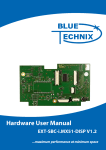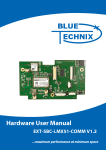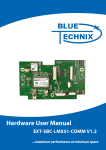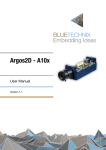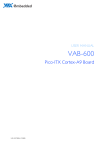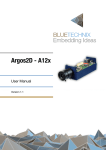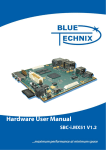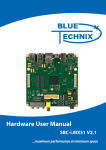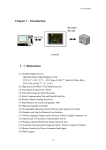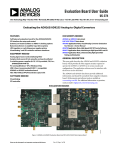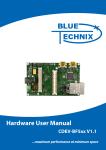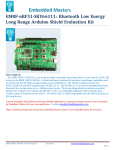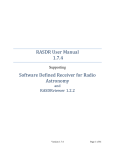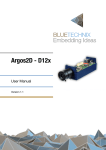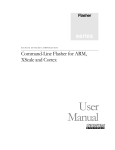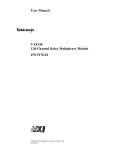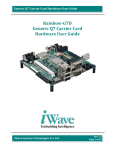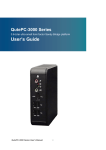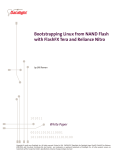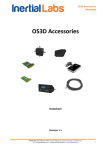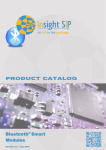Download Hardware User Manual
Transcript
Hardware User Manual DEV-i.MX53 V1.x Contact Bluetechnix Mechatronische Systeme GmbH Waidhausenstraße 3/19 A-1140 Vienna AUSTRIA/EUROPE [email protected] http://www.bluetechnix.com Document No.: 100-4120-1.2 Date: 2012-02-14 Preliminary_DEV-i.MX53_HUM_V1.2.docx 2 Table of Contents i.MX Core Modules..................................................................................................................................................................................... 6 i.MX Development Boards ...................................................................................................................................................................... 8 1 Introduction ....................................................................................................................................................................................... 9 1.1 Overview .................................................................................................................................................................................... 9 1.2 Available extensions ...........................................................................................................................................................10 1.3 Key Features ...........................................................................................................................................................................10 1.3.1 Core Modules ...............................................................................................................................................................10 1.3.2 Active Components on DEV-i.MX53....................................................................................................................10 1.3.3 Optional Parts on DEV-i.MX53 ...............................................................................................................................10 1.4 2 General Description ......................................................................................................................................................................12 2.1 3 4 Applications............................................................................................................................................................................10 Functional Description .......................................................................................................................................................12 2.1.1 Interface Interconnection........................................................................................................................................13 2.1.2 Powering ........................................................................................................................................................................13 2.1.3 Audio ...............................................................................................................................................................................13 2.1.4 HDMI ................................................................................................................................................................................14 2.1.5 JTAG .................................................................................................................................................................................14 2.1.6 USB/UART Bridge ........................................................................................................................................................14 2.1.7 USB ...................................................................................................................................................................................14 2.1.8 USB-OTG.........................................................................................................................................................................14 2.1.9 SDHC-Card.....................................................................................................................................................................14 2.1.10 SATA ................................................................................................................................................................................14 2.1.11 Ethernet ..........................................................................................................................................................................14 2.1.12 ISM Interface .................................................................................................................................................................14 2.1.13 CAN* ................................................................................................................................................................................15 2.1.14 LED Driver ......................................................................................................................................................................15 2.1.15 ADC ..................................................................................................................................................................................15 2.1.16 Acceleration Sensor ...................................................................................................................................................15 2.2 PCB Placement ......................................................................................................................................................................16 2.3 Mechanical Outline ..............................................................................................................................................................16 Specifications...................................................................................................................................................................................19 3.1 Operating Conditions .........................................................................................................................................................19 3.2 Maximum Ratings ................................................................................................................................................................19 3.3 Analog Inputs.........................................................................................................................................................................19 3.4 ESD Sensitivity .......................................................................................................................................................................19 Connector Description .................................................................................................................................................................20 Preliminary_DEV-i.MX53_HUM_V1.2.docx 3 4.1 Digital Video Extension Connector (X22) ....................................................................................................................20 4.1.1 Camera Sensor Interface Port (CSI0) ...................................................................................................................20 4.1.2 LCD Port (DISP0)..........................................................................................................................................................20 4.1.3 Pin Description Table ................................................................................................................................................20 4.2 GPIO/Automation Extension Connector (X23) .........................................................................................................22 4.2.1 Pin Description Table ................................................................................................................................................23 4.3 Image Sensor Connector X21 (BLT-ISM-Connector) ...............................................................................................26 4.4 Reset / Power-On Connector (X10)................................................................................................................................26 4.5 Auxiliary Power Supply Connector (X5).......................................................................................................................27 5 Switches, Jumpers and LEDs .....................................................................................................................................................28 5.1 RGB LED (V12) ........................................................................................................................................................................28 5.2 Push Buttons (S4, S3) ..........................................................................................................................................................28 5.3 Backup Battery (optional) .................................................................................................................................................28 5.4 Board Configuration Switches (S2, S1) .........................................................................................................................28 6 Support ..............................................................................................................................................................................................30 6.1 General Support....................................................................................................................................................................30 6.2 Board Support Packages ...................................................................................................................................................30 6.3 i.MX Software Support .......................................................................................................................................................30 6.3.1 Linux ................................................................................................................................................................................30 6.3.2 Win CE .............................................................................................................................................................................30 6.4 i.MX® Design Services ..........................................................................................................................................................30 6.4.1 7 Upcoming Products and Software Releases ....................................................................................................30 Ordering Information ...................................................................................................................................................................31 7.1 8 Predefined mounting options for DEV-i.MX53 .........................................................................................................31 Dependability ..................................................................................................................................................................................32 8.1 9 MTBF ..........................................................................................................................................................................................32 Product History ...............................................................................................................................................................................33 9.1 Version Information.............................................................................................................................................................33 9.2 Anomalies................................................................................................................................................................................33 10 Document Revision History ...................................................................................................................................................34 11 List of Abbreviations ................................................................................................................................................................35 A List of Figures and Tables............................................................................................................................................................37 Preliminary_DEV-i.MX53_HUM_V1.2.docx 4 © Bluetechnix Mechatronische Systeme GmbH 2012 All Rights Reserved. The information herein is given to describe certain components and shall not be considered as a guarantee of characteristics. Terms of delivery and rights of technical change reserved. We hereby disclaim any warranties, including but not limited to warranties of non-infringement, regarding circuits, descriptions and charts stated herein. Bluetechnix makes and you receive no warranties or conditions, express, implied, statutory or in any communication with you. Bluetechnix specifically disclaims any implied warranty of merchantability or fitness for a particular purpose. Bluetechnix takes no liability for any damages and errors causing of the usage of this board. The user of this board is responsible by himself for the functionality of his application. He is allowed to use the board only if he has the qualification. More information is found in the General Terms and Conditions (AGB). Information For further information on technology, delivery terms and conditions and prices please contact Bluetechnix (http://www.bluetechnix.com). Warning Due to technical requirements components may contain dangerous substances. Preliminary_DEV-i.MX53_HUM_V1.2.docx 5 i.MX Core Modules CM-i.MX27-C-C-Q26S128F32N512 The Core Module CM-i.MX27 is powered by Freescales' SoC i.MX27 (ARM 926 core, up to 400MHz). It addresses 128MB DDR-RAM, has an onboard NOR-flash of 32MByte and a NAND-flash with 512MByte at a size of 55x45mm. CM-i.MX31-C-C-Q26S128F40N128-E The Core Module CM-i.MX31 is powered by Freescales' SoC i.MX31 (ARM1136JF-S core, up to 532MHz). It addresses 128MB DDR-RAM, has an onboard NOR-flash of 40MByte and a NAND-flash with 128MByte at a size of 55x45mm. Core module is available as connector or BGA. CM-i.MX53-C-I-Q24S1024F4N2048) The Core Module CM-i.MX53 is powered by Freescales' SoC i.MX53 (ARM® Cortex™-A8, up to 1GHz). It addresses 1024MB DDR2-SDRAM, has an onboard NOR-flash of 4MByte and a NAND-flash with 2048MByte at a size of 80x45mm. Preliminary_DEV-i.MX53_HUM_V1.2.docx 6 Core Module naming information The idea is to put more Core Module specific technical information into the product name. New Core Module names will have following technical information covered in their names. • Product Family, • CPU-Type, • Connection-Type, • Operating Temperature Range, • Crystal Frequency [MHz], • RAM [MB], • Flash [MB], • External Controllers • Optional o Special and/or o Former name That expands of course the name but allows the customer to get the most important Core Module specific information at the first sight. Have a look at the example below to get an idea of the new Core Module names. Example CM-BF537-C-C-Q25S32F4 (CM-BF537E) CM - BF537 - C - C - Q25 S32 F4 - - (CM-BF537E) Product Family Former name CM = Core Module Special SBC = Single Board Computer Custom Core Modules or specials CPU-Type uC = uclinux Equals the name of CPU Extra controllers mounted Connection-Type E = Ethernet A = BGA U = USB B = Border pad Flash [MB] C = Connector F = NOR Flash [MB] S = SSpecial N = NAND Flash [MB] Operating Temperature Range RAM A = Automotive (-40° to +125°) S = SDRAM [MB] C = Commercial (0° to +70°) I = Industry (-40° to +85°) Crystal Frequency Notation: QXX[MHz] Preliminary_DEV-i.MX53_HUM_V1.2.docx 7 i.MX Development Boards DEV-i.MX27 The DEV-i.MX27 development board is an extendable development platform for the CM-i.MX27 processor modules. With display connector and keypad it can be used as a reference design for a low power mobile handheld device powered by a single Lithium Ion battery. The development board provides all interfaces of the connector version on dedicated expansion connectors. Extender boards can be plugged on top of the development board in order to enable additional interfaces. DEV-iMX31 The DEV-i.MX31 Development Board is an extendable development platform for the CM-i.MX31 processor module. With display connector and keypad it can be used as a reference design for a low power mobile handheld device powered by a single Lithium Ion battery. The development board provides all interfaces of the connector version on dedicated expansion connectors. Extender boards can be plugged on top of the development board in order to enable additional interfaces. SBC-i.MX51-S-C-Q24S512N2048 The Single-Board Computer SBC-i.MX51 is based on Freescale’s high-performance i.MX51 mobile platform, incorporating an ARM Cortex-A8 CPU, an Image Processing Unit (IPUv3EX), a Video Processing Unit (VPU) and a Graphical Processing Unit (GPU). The IPUv3EX provides comprehensive support for connectivity to displays and cameras. The VPU supports hardware encoding and decoding of MPEG-4, H.263, H.264 and many more standards. The GPU serves 3D and 2Dacceleration in hardware. The board‘s memory capabilities (NAND Flash, DDR2) and numerous interfaces like Ethernet, HDMI,4xUSB and USB-OTG turn the SBC-i.MX51 into the ultimate development board for future high-end embedded devices. DEV-i.MX53 The DEV-i.MX53 development board is an extendable development platform for the CM-i.MX53 processor module. The development board provides all interfaces of the connector version (Ethernet, HDMI,4xUSB and USB-OTG) on dedicated extender connectors. Extender boards can be plugged on top of the development board in order to enable additional interfaces. Extender boards Extender boards (EXT-SBC-i.MX51-) are expanding the development board SBC-i.MX51 by several interfaces and functionalities. Targeted application areas are: audio/video processing, security and surveillance, Ethernet access, positioning, automation and control, experimental development and measuring. Note! Bluetechnix is offering tailored board developments as well. Preliminary_DEV-i.MX53_HUM_V1.2.docx 8 1 Introduction The DEV-i.MX53 Development Board is a feature rich, low cost rapid development platform designed to decrease time-to-market of customized applications. It supports Bluetechnix’ powerful i.MX53 based Core Module. The development board provides all interfaces on dedicated connectors and features the latest extender socket (bottom side) for upcoming extender boards. The form factor of the DEV-i.M5x allows easy integration of the board into OEM products. In combination with any of Bluetechnix’ CM-i.MX53 the DEV-i.MX53 is a future proof embedded development platform for high sophisticated applications in all areas! Target applications include industrial automation and control systems as well as applications making use of the extensive video features. Overview HDMI 4 x USB-A Mini-USB-B USB-OTG JTAG HDMI Transmitter USB-HUB UART-USB Bridge RJ45 CAN i/f CAN Video Extender SATA Serial I/O Extender 1.1 CM-i.MX53 1-Wire / I2C Speaker-Out 3-axis Accelerometer Mic-In On-Board Mic RGB-LED Driver Reset Button, Power On Button DC-Plug Line-In Headphone-Out RGB LED SDHC Card Slot Camera Interface Core Module Active Components User Interfaces Connectors Figure 1-1: Overview of the main components Preliminary_DEV-i.MX53_HUM_V1.2.docx 9 1.2 Available extensions In addition, different extensions boards from Bluetechnix are available. Further boards are added based on the number of customer demands. All specifications you need to design a custom board of your own are freely available so you can start your design right away. Bluetechnix also offers design support for your custom extensions. The following extensions are currently planned and will be available soon. • • 1.3 EXT-i.MX53-COMM o GPS o GSM o UMTS o Bluetooth/WLAN o Display Interface for TFT Displays with RGB interface o Two Display Interfaces for TFT Displays with LVDS interface o Image Sensor Interface EXT-i.MX53-EXP o Experimental board making every pin on the extension board available on a test point (allows for rapid prototyping) Key Features 1.3.1 Core Modules The DEV-i.MX53 allows the use of i.MX Core Modules based on the i.MX53 processor family. 1.3.2 • • • • • • • 1.3.3 • • • Active Components on DEV-i.MX53 HDMI/DVI Transmitter (Analog Devices AD9889) 7 Port USB HUB (SMSC USB2517) DC-DC Converters (5.0V: LM3485; 3.3V: ADP2301; 1.8V: ADP2108) USB/UART Bridge (Silicon Labs CP2104) CAN Transceiver (TI SN65HVD232D) RGB-LED driver with I²C interface (Toshiba TCA62724FMG) 4 Channel ADC (AD7993) for voltage monitoring or resistive touch panels Optional Parts on DEV-i.MX53 On-board microphone (Knowles Acoustics SPM0208HD5) Acceleration sensor (Freescale MMA7660FCR1) 2x 2.5W Audio Amp (ON-Semi NCP2820FCT2G) Please understand that these are only active parts and require additional connectors and passive parts as well. We provide information regarding these parts on request. 1.4 Applications • Automotive infotainment • Single Board Computer • Tablets Preliminary_DEV-i.MX53_HUM_V1.2.docx 10 • Smart Mobile Devices • Human-Machine-Interface • Medical Devices • Video Conference Systems • Imaging and Consumer Multimedia • Set Top Boxes • Video Conference Applications • Portable Media Players • Industrial Applications • High-end Mobile Internet Devices (MID), High-end PDAs • Netbooks (web tablets) • Nettops (internet desktop devices) • High-end portable media players (PMP) with HD video capability • Portable navigation devices (PND) Preliminary_DEV-i.MX53_HUM_V1.2.docx 11 2 General Description The DEV-i.MX53 is a development board for i.MX Core Modules based on the ARM Cortex A8™ core (CM-i.MX53). The development board features a broad spread selection of available interfaces from the Core Module, like USB, USBOTG, Ethernet, SATA, SD-Card, HDMI, CAN*, and analog audio. In addition there is the possibility to access unused interfaces by applying an extension board to the extension connectors located on the bottom side. * Available only for Industrial Core Modules (see chapter 7). 2.1 Functional Description Figure 2-1 shows the on-board components and how they are connected to the Core Module. A more precise listing including which interface is routed to which board extension connectors is shown in the interconnection tables below. USB-OTG SATA Reset Button, Power On Button RJ45 DC/DC Regulators DC-Plug USBH2 USB-HUB 4 x USB-A Bootmode Switches SATA Camera Interface CSI0 UART1 UART-USB Bridge Mini-USB-B SDHC Card Slot SD3 DISP1 HDMI Transmitter HDMI CAN1 CAN i/f CAN I²C2 RGB-LED Driver Power LED, RGB LED 2.5W Audio Amp Speaker-Out LAN USBOTG CM-i.MX53 14-pin 2.54mm Header JTAG I²C2 3-axis Accelerometer 4 Channel ADC Audio Interface Video Extender Serial I/O Extender Line-In Core Module Headphone-Out Active Components Mic-In User Interfaces On-Board Mic Connectors CM Interfaces Figure 2-1: DEV-i.MX53 Interconnection Diagram Preliminary_DEV-i.MX53_HUM_V1.2.docx 12 2.1.1 Interface Interconnection The following table lists all available interfaces from the Core Module and how they are interconnected on the Development Board. Interface AUDIO AUD5 CAN1 eCSPI1 eCSPI2 eSDHC2 eSDHC3 FIRI CSI0 DI0 DI1 LAN LVDS0 LVDS1 OWIRE PWM I²C2 Category Analog Audio Digital Audio CAN SPI SPI SD-Card SD-Card UART (IrDA) IPU IPU IPU Ethernet LDB LDB OWIRE PWM I²C Pins 8 6 2 5 5 11 6 2 14 21 27 6 10 10 1 2 2 I²C3 SATA UART1 UART2 UART3 USBOTG USBH1 I²C SATA UART UART UART USB USB 2 4 2 4 4 2 2 Connected to Triple 3.5mm Audio Jack HDMI Transmitter CAN Transceiver Extension Connector Extension Connector Extension Connector SD-Card Extension Connector BLT-ISM interface; Extension Connector Extension Connector HDMI Transceiver RJ45 Socket Extension Connector Extension Connector Extension Connector Extension Connector RGB-LED Driver, Acceleration Sensor, HDMI Transmitter, Extension Connector Extension Connector Serial ATA Connector UART-USB Bridge Extension Connector Extension Connector Mini USB-AB Connector USB Hub Comment SS0 + SS1 SS0 + SS1 8-bit 4-bit 2-bit 10-bit 18-bit 24-bit Pull-Ups on Board No Pull-Ups Supply for 2.5” HDD Table 2-1: CM-i.MX53 Interface routing 2.1.2 Powering The DEV-i.MX53 works with a single power supply of 12V to 16V. This input voltage is also routed to the extension connectors and can be used there, e.g. for TFT backlight etc. If stand-alone operation is desired, an auxiliary plug provides the option to connect a Li-Ion battery pack with an external battery charger. 2.1.3 Audio The audio interface is used to deliver a standard PC audio interface with Microphone-In, Line-In and Line-Out. Standard 3,5mm audio jacks are used. A Headset can be connected to the Microphone-In and Line-Out connectors. On request there is the possibility to mount two 2.5W amps. The speakers can be applied to the screw-less terminal connectors X18 and X19. On request an on-board microphone can be mounted next to the audio jacks. Preliminary_DEV-i.MX53_HUM_V1.2.docx 13 2.1.4 HDMI The HDMI connector provides a standard interface for digital video and audio signals. The HDMI/DVI transmitter is preprocessing the video signal from the IPU. The audio stream comes from the AUD5 interface of the i.MX53x. The device can be accessed via the I²C1 bus with the device address 0x39. 2.1.5 JTAG A standard ARM JTAG connector (20 pins, 2.54mm pitch) is available for processor debugging. 2.1.6 USB/UART Bridge The UART1 is connected to a SiLabs CP210x, which implements the USB to UART Bridge. A mini USB-B connector is connected to the device. 2.1.7 USB The USBH1 port of the DEV-i.MX53 is connected to a seven port USB HUB (SMSC USB2517). Consequently the board features four standard USB-A connectors, three USB lanes are routed to the IO-extension connector. 2.1.8 USB-OTG The i.MX53’ internal USB-OTG PHY is routed to a mini USB-A/B connector. 2.1.9 SDHC-Card The SDHC-Card signals are directly connected to the SD3 port of the CM-i.MX53. A standard SD-Card connector mounted on the bottom side of the board supports SD and SDHC cards. 2.1.10 SATA The DEV-i.MX53 allows connecting one SATA HDD or SSD. The 5.0V supply which is needed for most 2.5” HDDs or SSDs is available on the screw-less terminal connector X25. If a 3.5” HDD is needed, the power supply has to be realized externally. The user has to make sure, that no more than 500mA will be drawn from the 5.0V terminal. A 1A fuse is populated on the DEV-board. 2.1.11 Ethernet As the Ethernet PHY is already integrated on the Core Module, the LAN signals are routed directly to a RJ45 LAN connector. 2.1.12 ISM Interface The camera sensor interface signals (CSI0) are routed to a 30 pin ZIF connector. The connector is compatible to the Bluetechnix ISM interface and allows connecting all available Image Sensor Modules from Bluetechnix. Preliminary_DEV-i.MX53_HUM_V1.2.docx 14 2.1.13 CAN* A SN65HVD232D CAN transceiver is present on the Development Board, which allows integrating the board into a CAN bus infrastructure. A termination resistor is designed-in, but not populated. If the termination is needed, a 120Ω 0402 SMD resistor can be soldered. * Available only for Industrial Core Modules (see chapter 7). 2.1.14 LED Driver A RGB LED is mounted for status signaling. The LED is connected to a TCA62724FMG I²C RGB LED driver. The device can be accessed via the I²C1 bus with the device address 0x55. 2.1.15 ADC The AD7993 analog to digital converter has two possible functions. By default it can be used for battery supervisory to measure battery voltage and charging current. If the battery charger won’t be used, the four channels are available on the extension connectors and it is possible to connect them to a touch screen panel. The device can be accessed via the I²C1 bus with the device address 0x22. 2.1.16 Acceleration Sensor The on-board 3-axis acceleration sensor MMA7660FC is connected to the I²C2 bus and is accessible via address 0x4C. Preliminary_DEV-i.MX53_HUM_V1.2.docx 15 2.2 PCB Placement Figure 2-2: Top connectors placement 2.3 Mechanical Outline This section shows the position of all connectors and mounting holes. All dimensions are given in mm. Preliminary_DEV-i.MX53_HUM_V1.2.docx 16 Figure 2-3: DEV-i.MX53 top view Preliminary_DEV-i.MX53_HUM_V1.2.docx 17 Figure 2-4: DEV-i.MX53 bottom view Preliminary_DEV-i.MX53_HUM_V1.2.docx 18 3 Specifications 3.1 Operating Conditions Symbol VIN P VUSBx IUSBx Parameter Input supply voltage Board Power Consumption1) USB Supply Voltage USB Supply Current Min 12 Typical 12 TBD 5.0 - 4.5 - Max 16 TBD 5.5 500 Unit V W V mA Table 3-1: Electrical characteristics The Power consumption refers to a CM-i.MX53 with Android running in idle state and no Extension Boards or USBDevices plugged in. 1) 3.2 Maximum Ratings Stressing the device above the rating listed in the absolute maximum ratings table may cause permanent damage to the device. These are stress ratings only. Operation of the device at these or any other conditions greater than those indicated in the operating sections of this specification is not implied. Exposure to absolute maximum rating conditions for extended periods may affect device reliability. Symbol VIO VIN IOH /IOL TAMB TSTO φAMB Parameter Input or output voltage Input supply voltage Current per pin Ambient temperature Storage temperature Relative ambient humidity Min -0.5 TBD 0 -40 -55 Max 3.6 TBD 10 85 150 90 Unit V V mA °C °C % Table 3-2: Absolute maximum ratings 3.3 Analog Inputs The 10-bit ADC, which is integrated in the AD7993BRUZ-0, allows measuring analog voltages. These analog inputs are mainly used for resistive touchpad sensing or voltage (battery) monitoring. Parameter Resolution Conversion Core Input Voltage Conversion Time Per Channel Symbol Min Vin tc 0 Typ. 10 - Max 3.3 2 Unit Bit V µs Table 3-3: ADC characteristics 3.4 ESD Sensitivity ESD (electrostatic discharge) sensitive device. Charged devices and circuit boards can discharge without detection. Although this product features patented or proprietary protection circuitry, damage may occur on devices subjected to high energy ESD. Therefore, proper ESD precautions should be taken to avoid performance degradation or loss of functionality. Preliminary_DEV-i.MX53_HUM_V1.2.docx 19 4 Connector Description 4.1 Digital Video Extension Connector (X22) The video extension connector allows customers to design their own video extension with user-defined camera and display components. A 100-pin-0.5mm-pitch mezzanine connector FX-10A-100S/10SV_M from Hirose (mating part is FX10A-100P/10-SV) is used. 4.1.1 Camera Sensor Interface Port (CSI0) A camera or an alternative video device (such as the OV2655 or the ADV7180) can be connected to the DEV-i.MX53 board using the CMOS Sensor Interface 0 (CSI0). Width (bit) 10 5 2 14 Interface CSI0 CSI0 I2C1 Power Description CSI0.D0 – CSI0.D9 CSI0.VSYNC, CSI0.HSYNC, CSI0.VSYNC, CSI0.PCLK, CSI0.DE I2C1.SDA, I2C1.SCL - Camera control interface 3V3, P_SW3_2V5, 5V0, VIN, GND Table 4-1: CSI port overview 4.1.2 LCD Port (DISP0) The DISP0 interface is available to connect an LCD display and a touch screen to the DEV-i.MX53 board. The i.MX53 supports display resolutions up to 1680X1050 (WSXGA+). Width (bit) 16 4 1 10 10 15 Interface DISP0 DISP0 PWM LVDS1 LVDS0 Power Description DISP0.D0 – DISP0.D17 DISP0.VSYNC, DISP0.HSYNC, DISP0.CLK, DISP0.DE CRTL.PWM2 LVDS1 interface LVDS0 interface 3V3, P_SW3_2V5, 5V0, VIN, GND Table 4-2: LCD port overview 4.1.3 Pin Description Table Pin No 1 2 3 4 5 6 7 8 9 10 11 12 13 Signal GND GND GND 5V0 5V0 DISP0.D1 DISP0.D3 DISP0.D5 DISP0.D7 GND DISP0.D9 DISP0.D11 DISP0.D13 Type PWR PWR PWR PWR PWR O O O O PWR O O O Preliminary_DEV-i.MX53_HUM_V1.2.docx Description Power Ground Power Ground Power Ground Power Supply Power Supply Display Port 0 Data Display Port 0 Data Display Port 0 Data Display Port 0 Data Power Ground Power Ground Display Port 0 Data Display Port 0 Data 20 Pin No 14 15 16 17 18 19 20 21 22 23 24 25 26 27 28 29 30 31 32 33 34 35 36 37 38 39 40 41 42 43 44 45 46 47 48 49 50 51 52 53 54 55 56 57 58 59 60 61 62 63 64 65 66 Signal DISP0.D15 DISP0.D17 GND DISP0.CLK GND CSI0_D10 CSI0_D10 CSI0_D10 CSI0_D10 CSI0_D10 CSI0_D10 CSI0_D10 CSI0_D10 CSI0_D10 CSI0_D10 GND CSI0_DE GND CSI0_PCLK GND CSI0_HSYNC CSI0_VSYNC LVDS1.CLK_N LVDS1.CLK_P LVDS1.TX0_N LVDS1.TX0_P LVDS1.TX1_N LVDS1.TX1_P LVDS1.TX2_N LVDS1.TX2_P LVDS1.TX3_N LVDS1.TX3_P P_SW3_2V5 P_SW3_2V5 GND GND GND GND GND GND 3V3 3V3 LVDS0.TX3_P LVDS0.TX3_N LVDS0.TX2_P LVDS0.TX2_N LVDS0.TX1_P LVDS0.TX1_N LVDS0.TX0_P LVDS0.TX0_N LVDS0.CLK_P LVDS0.CLK_N GPIO4_1 Type O O PWR O PWR IO IO IO IO IO IO IO IO IO IO PWR O PWR I PWR I I IO IO O O O O O O O O PWR PWR PWR PWR PWR PWR PWR PWR PWR PWR O O O O O O O O IO IO IO Preliminary_DEV-i.MX53_HUM_V1.2.docx Description Display Port 0 Data Display Port 0 Data Power Ground Display Port 0 Clock Power Ground CMOS sensor interface 0 Data CMOS sensor interface 0 Data CMOS sensor interface 0 Data CMOS sensor interface 0 Data CMOS sensor interface 0 Data CMOS sensor interface 0 Data CMOS sensor interface 0 Data CMOS sensor interface 0 Data CMOS sensor interface 0 Data CMOS sensor interface 0 Data Power Ground CMOS sensor interface 0 Data Enable Power Ground CMOS sensor interface 0 Pixel Clock Power Ground CMOS sensor interface 0 HSYNC CMOS sensor interface 0 VSYNC LVDS Clock (-) LVDS Clock (+) LVDS Transmit Data0 (-) LVDS Transmit Data0 (+) LVDS Transmit Data1 (-) LVDS Transmit Data1 (+) LVDS Transmit Data2 (-) LVDS Transmit Data2 (+) LVDS Transmit Data3 (-) LVDS Transmit Data3 (+) Power Supply Power Supply Power Ground Power Ground Power Ground Power Ground Power Ground Power Ground Power Supply Power Supply LVDS Transmit Data3 (+) LVDS Transmit Data3 (-) LVDS Transmit Data2 (+) LVDS Transmit Data2 (-) LVDS Transmit Data1 (+) LVDS Transmit Data1 (-) LVDS Transmit Data0 (+) LVDS Transmit Data0 (-) LVDS Clock (+) LVDS Clock (-) Camera Output Enable 21 Pin No 67 68 69 70 71 72 73 74 75 76 77 78 79 80 81 82 83 84 85 86 87 88 89 90 91 92 93 94 95 96 97 98 99 100 Signal GPIO4_0 GPIO4_2 VGAGND RGB.R VGAGND RGB.G VGAGND RGB.B VGAGND NC I2C1.SCL I2C1.SDA NC CTRL.PWM2 GND DISP0.DE DISP0.VSYNC DISP0.HSYNC GND DISP0.D16 DISP0.D14 DISP0.D12 DISP0.D10 DISP0.D8 GND DISP0.D6 DISP0.D4 DISP0.D2 DISP0.D0 VIN VIN GND GND GND Type O O PWR O PWR O PWR O PWR NC IO IO NC O PWR O I I PWR O O O O O PWR O O O O PWR PWR PWR PWR PWR Description Camera Trigger Global Camera Reset Power Ground AV Out Red Power Ground AV Out Green Power Ground AV Out Black Power Ground Not Connected I2C Clock I2C Data Not Connected PWM Power Ground Display Port 0 Data Enable Display Port 0 Data VSYNC Display Port 0 Data HSYNC Power Ground Display Port 0 Data Display Port 0 Data Display Port 0 Data Display Port 0 Data Display Port 0 Data Power Ground Display Port 0 Data Display Port 0 Data Display Port 0 Data Display Port 0 Data Power Supply Power Supply Power Ground Power Ground Power Ground Table 4-3: Digital video extension connector (X22) pin description 4.2 GPIO/Automation Extension Connector (X23) The GPIO / automation extension connector allow customers to design their own GPIO extension with user-defined components. A 100-pin-0.5-pitch mezzanine connector (FX-10A-100S/10SV_M from Hirose (mating part is FX10A100P/10-SV) is used. Many interfaces have alternate functions and can also be used as GPIOs. Interface 1-Wire Analog-In I2C PWM SD SPI Width (bit) 1 4 2 2 12 10 Interface OWIRE ADIN I2C3 PWM1, PWM2 SD2 ECSPI1, ECSPI2 Preliminary_DEV-i.MX53_HUM_V1.2.docx Description OWIRE ADIN[1..4] I2C3.SCL, I2C3.SDA PWM1, PWM2 SD2.CMD, SD2.CLK, SD2.WP, SD2.CD. SD2.D0 – SD2.D7 ECSPI1.MOSI, ECSPI1.MISO, ECSPI1.SS0, ECSPI1.SS1, ECSPI1.SCLK ECSPI2.MOSI, ECSPI2.MISO, ECSPI2.SS0, ECSPI2.SS1, ECSPI2.SCLK 22 Interface UART Width (bit) 8 Interface UART2, UART3 CAN USB 2 12 FIRI Power 2 35 CAN1 USBH5, USBH6, USBH7 FIRI Description UART2.TXD, UART2.RXD, UART2.RTS, UART2.CTS UART3.TXD, UART3.RXD, , UART3.RTS, UART3.CTS CAN1.RXD, CAN1.TXD USBH5.D_P, USBH5.D_N, USBH5.PWR, USBH5.OC USBH6.D_P, USBH6.D_N, USBH6.PWR, USBH6.OC USBH7.D_P, USBH7.D_N, USBH7.PWR, USBH7.OC FIRI.RXD, FIRI.TXD 5V0, VIN, VUSB5, P_SW3_2V5, 3V3, P_LDO4_2V8, GND Table 4-4: GPIO / automation extension connector (X23) port overview 4.2.1 Pin Description Table Pin No 1 2 3 4 5 6 7 8 9 10 11 12 13 14 15 16 17 18 19 20 21 22 23 24 25 26 27 28 29 30 31 32 33 34 35 36 Signal GND GND GND 5V0 5V0 USBH7.D_P USBH7.D_N USBH7.PWR USBH7.OC GND I2C3.SCL I2C3.SDA OWIRE VUSB5 VUSB5 CAN1.RXD CAN1.TXD P_LDO4_2V8 GPIO.(2V8)_3 GPIO.(2V8)_4 GND UART2.RXD UART2.TXD UART2.RTS UART2.CTS GND UART3.RXD UART3.TXD UART3.RTS UART3.CTS FIRI.RXD FIRI.TXD GND NC CTRL.PWM1 CTRL.PWM2 Type PWR PWR PWR PWR PWR IO IO O I PWR O IO IO PWR PWR I O PWR IO IO PWR I O O I PWR I O O I O I PWR NC O O Preliminary_DEV-i.MX53_HUM_V1.2.docx Description Power Ground Power Ground Power Ground Power Supply Power Supply USB Data+ USB DataUSB Power Enable USB Over Current Power Ground I2C Clock I2C Data One Wire Interface 500mA Current Limited 5V Power Supply for USB Host 5 500mA Current Limited 5V Power Supply for USB Host 5 CAN Receive Data / GPIO4_11 CAN Transmit Data / GPIO4_10 Power Supply GPIO4_3 GPIO4_4 Power Ground UART Receive Data UART Transmit Data UART Request To Send UART Clear To Send Power Ground UART Receive Data UART Transmit Data UART Request To Send UART Clear To Send Fast Infrared Interface Receive Data Fast Infrared Interface Transmit Data Power Ground Not Connected Pulse Width Modulation Output / GPIO1_9 Pulse Width Modulation Output / GPIO1_19 23 Pin No 37 38 39 40 41 42 43 44 45 46 47 48 49 50 51 52 53 54 55 56 57 58 59 60 61 62 63 64 65 66 67 68 69 70 71 72 73 74 75 76 77 78 79 80 81 82 83 84 85 Signal P_SW3_2V5 NC GND ECSPI2.MOSI ECSPI2.MISO ECSPI2.SS1 ECSPI2.SS2 NC ECSPI2.SCLK 3V3 3V3 GND GND GND GND GND GND VIN VIN ECSPI1.SCLK NC ECSPI1.SS1 ECSPI1.SS0 ECSPI1.MISO ECSPI1.MOSI GND ADIN4 ADIN3 ADIN2 ADIN1 SD2.D7 SD2.D6 SD2.D5 SD2.D4 SD2.D3 SD2.D2 SD2.D1 SD2.D0 GND SD2.CLK SD2.CMD GND SD2.WP SD2.CD P_SW3_2V5 GPIO.(2V5)_3 GPIO.(2V5)_2 GPIO.(2V5)_1 GPIO.(2V5)_0 Type PWR NC PWR O I O O NC O PWR PWR PWR PWR PWR PWR PWR PWR PWR PWR O NC O O I O PWR I I I I IO IO IO IO IO IO IO IO PWR O O PWR I I PWR IO IO IO IO Preliminary_DEV-i.MX53_HUM_V1.2.docx Description Power Supply Not Connected Power Ground SPI MOSI SPI MISO SPI Select1 SPI Select2 Not Connected SPI CLK Power Supply Power Supply Power Ground Power Ground Power Ground Power Ground Power Ground Power Ground Power Supply Power Supply SPI CLK Not Connected SPI Select1 SPI Select0 SPI MISO SPI MOSI Power Ground Vin4 (AD7993) Vin3 (AD7993) Vin2 (AD7993) Vin1 (AD7993) SD Data7 / GPIO2_15 SD Data6 / GPIO2_14 SD Data5 / GPIO2_13 SD Data4 / GPIO2_12 SD Data3 / GPIO1_12 SD Data2 / GPIO1_13 SD Data1 / GPIO1_14 SD Data0 / GPIO1_15 Power Ground SD Clock / GPIO1_10 SD Command / GPIO1_11 Power Ground SD Card Detect / GPIO2_31 SD Write Protect / GPIO1_2 Power Supply GPIO5_13 GPIO1_18 GPIO1_17 GPIO1_16 24 Pin No 86 87 88 89 90 91 92 93 94 95 96 97 98 99 100 Signal GND USBH5_OC USBH5_PWR USBH5_D_N USBH5_D_P GND USBH6_OC USBH6_PWR USBH6_D_N USBH6_D_P 5V0 5V0 GND GND GND Type PWR I O IO IO PWR I O IO IO PWR PWR PWR PWR PWR Description Power Ground USB Over Current USB Power Enable USB DataUSB Data+ Power Ground USB Over Current USB Power Enable USB DataUSB Data+ Power Supply Power Supply Power Ground Power Ground Power Ground Table 4-5: GPIO / automation extension connector (X23) pin description Preliminary_DEV-i.MX53_HUM_V1.2.docx 25 4.3 Image Sensor Connector X21 (BLT-ISM-Connector) Pin 1 2 3 4 5 6 7 8 9 10 11 12 13 14 15 16 17 18 19 20 21 22 23 24 25 26 27 28 29 30 Name VCAMA GND SADDR NC GPIO4_2 I2C1.SCL I2C1.SDA VCAMC GND CSI0.PCLK CSI0.VSYNC CSI0.HSYNC GPIO4_0 STROBE NC NC CSI0.D0 CSI0.D1 VCAMIO GND CSI0.D2 CSI0.D3 CSI0.D4 CSI0.D5 GND CSI0.D6 CSI0.D7 CSI0.D8 CSI0.D9 CSI0.DE Type PWR PWR NC NC O O I/O PWR PWR I I I O I NC NC I I PWR PWR I I I I PWR I I I I O Description Camera Analog Voltage Supply Power Ground Not Connected Not Connected Global Camera Reset Configuration Bus Clock Line Configuration Bus Data Line Camera Core Voltage Supply Power Ground Pixel Clock VSYNC HSYNC Camera Trigger Strobe Signal from Camera (available only on solder pad) Not Connected Not Connected Pixel Data Pixel Data Camera IO Power Supply Power Ground Pixel Data Pixel Data Pixel Data Pixel Data Power Ground Pixel Data Pixel Data Pixel Data Pixel Data Output Enable (Active Low) Table 4-6: BLT-ISM-Connector interface description (X21) 4.4 Reset / Power-On Connector (X10) The two signals Power-On and Reset are accessible via this connector. These signals are the same as the ones routed to the two push buttons. Pin No 1 2 3 4 Signal CTRL.ON GND CTRL.NRESET_IN GND Description Power On (internally pulled up) Signal ground Power On Reset (internally pulled up) Signal ground Table 4-7: Reset / power-on connector pin description Preliminary_DEV-i.MX53_HUM_V1.2.docx 26 4.5 Auxiliary Power Supply Connector (X5) The auxiliary Power Supply Extension Connector provides the possibility to power the board via a 12-pin Connector (ERNI 063179). It is possible to connect a supply voltage to the Vin Pins, or to connect an external battery charger. Pin No 1A 2A 3A 4A 5A 6A Signal I²C1.SCL I²C1.SDA PWR_GT GND CHRG_IN CHRG_IN Description I²C1 Serial Clock I²C1 Serial Data Power Gate (for DC Connector) Power Ground Power Supply for External Charger Power Supply for External Charger Pin No 1B 2B 3B 4B 5B 6B Signal GPIO5_13 GPIO1_18 GPIO1_17 GND Vin Vin Description Free Configurable Control IO Free Configurable Control IO Free Configurable Control IO Power Ground Dev-Board Power Supply Dev-Board Power Supply Table 4-8: Auxiliary power supply extension connector pin description Preliminary_DEV-i.MX53_HUM_V1.2.docx 27 5 Switches, Jumpers and LEDs 5.1 RGB LED (V12) The RGB LED is connected to the TCA62724FMG RGB-LED driver and can be used for status signaling. 5.2 Push Buttons (S4, S3) The push buttons have the following functions: • • 5.3 S3: RESET S4: Power On/Off Backup Battery (optional) There is also a possibility to add a 6.8mm non-rechargeable lithium coin cell to keep the RTC running and the RAM self-refreshing. The DEV/i.MX53 is delivered only on request with a 6.8mm coin cell holder. Bluetechnix does not provide any batteries due to legal restrictions. 5.4 Board Configuration Switches (S2, S1) The DEV-i.MX53 supports five different boot modes. For USB/UART boot mode, the i.MX53 is polling for activity on both USBOTG and UART1. For a more detailed explanation please see the software documentation on http://support.bluetechnix.at/wiki. Preliminary_DEV-i.MX53_HUM_V1.2.docx 28 Mode Switch Boot Switch Setting On Off S2 1 Boot Media 1 2 3 4 5 6 7 8 On Off S1 SPI NOR Flash 1 2 3 4 5 6 7 8 On Off S2 2 1 2 3 4 5 6 7 8 On Off S1 NAND Flash (Consumer Core Module Version) 1 2 3 4 5 6 7 8 On Off S2 3 1 2 3 4 5 6 7 8 On Off S1 NAND Flash (Industrial Core Module Version) 1 2 3 4 5 6 7 8 On Off S2 4 1 2 3 4 5 6 7 8 On Off S1 SD card 1 2 3 4 5 6 7 8 On Off S2 5 1 2 3 4 5 6 7 8 On Off S1 SATA hard disk 1 2 3 4 5 6 7 8 On Off S2 6 1 2 3 4 5 6 7 8 On Off S1 USB/UART boot mode 1 2 3 4 5 6 7 8 Table 5-1: Supported Boot Modes Preliminary_DEV-i.MX53_HUM_V1.2.docx 29 6 Support 6.1 General Support General support for products can be found at Bluetechnix’ support site https://support.bluetechnix.at/wiki 6.2 Board Support Packages Board support packages, boot loaders and further software downloads can be downloaded at the products wiki page at https://support.bluetechnix.at/wiki 6.3 6.3.1 i.MX Software Support Linux Linux BSP and images of derivates can be found at Bluetechnix’ support site https://support.bluetechnix.at/wiki at the software section of the related product. 6.3.2 Win CE WinCE is only supported on ARM platforms. Please contact Bluetechnix for support information. 6.4 i.MX® Design Services Based on more than seven years of experience with Blackfin and i.MX, Bluetechnix offers development assistance as well as custom design services and software development. 6.4.1 Upcoming Products and Software Releases Stay up to date with all at http://www.bluetechnix.com. product Preliminary_DEV-i.MX53_HUM_V1.2.docx changes, releases and software updates of Bluetechnix 30 7 Ordering Information 7.1 Predefined mounting options for DEV-i.MX53 Article Number 100-4120-1 100-1470-2 100-1471-2 100-1472-2-TR Name i.MX53 Development Starter Package CM-i.MX53-C-I-Q24S1024F4N2048 CM-i.MX53-C-C-Q24S1024F4N2048 CM-i.MX53-C-C-Q24S512F4N256 Description DEV-i.MX5x + CM-i.MX53-C-C-Q24S1024F4N2048 Industrial version Commercial version Tape Reel (Commercial version, 50 pcs per reel) Table 7-1: Ordering information NOTE: Custom hard and software developments are available on request! Please contact Bluetechnix ([email protected]) if you are interested in custom hard- and software development. Preliminary_DEV-i.MX53_HUM_V1.2.docx 31 8 Dependability 8.1 MTBF Please keep in mind that a part stress analysis would be the only way to obtain significant failure rate results, because MTBF numbers just represent a statistical approximation of how long a set of devices should last before failure. Nevertheless, we can calculate an MTBF of the development board using the bill of material. We take all the components into account. The PCB and solder connections are excluded from this estimation. For test conditions we assume an ambient temperature of 30°C of all development board components. We use the MTBF Calculator from ALD (http://www.aldservice.com/) and use the reliability prediction MIL-217F2 Part Stress standard. Please get in touch with Bluetechnix ([email protected]) if you are interested in the MTBF result. Preliminary_DEV-i.MX53_HUM_V1.2.docx 32 9 Product History 9.1 Version Information Version 1.2 Date 2011 11 24 1.1 2011 08 23 9.2 Changes Battery charger removed. Coin cell Holder not mounted. Core Module mounting holes adapted for new modules (Version V2.0 or higher). Two different extension connectors to prevent reverse connecting of extension boards. Optional plug to connect an external Li-Ion battery pack with charger. Pin out of extension connector X22 changed (Pin 66 from NC to Cam_OE). First DEV-i.MX53 release Table 9-1: Overview product changes Anomalies Version 1.2 1.1 Date 2011 11 24 2011 10 02 Description No anomalies reported yet. Power Supplies for USB Lane 1 and Lane 2 interchanged. Over-current detection will not work. Table 9-2: Overview product anomalies Preliminary_DEV-i.MX53_HUM_V1.2.docx 33 10 Document Revision History Version 2 1 Date 2011 11 24 2011 09 05 Document Revision Updates for HWR V1.2 First draft release Table 10-1: Revision history Preliminary_DEV-i.MX53_HUM_V1.2.docx 34 11 List of Abbreviations Abbreviation ADC ADIN AI CAN CM COMM CSI DC DDR DEV DI DISP EBI ESD EXP FIRI GPIO GPS GSM HD HDD HDMI I I/O I²C ISM JTAG LAN LiPol LVDS MIC MTBF NC O OEM OWIRE PCB PDA PWM PWR SATA SD SDHC SDRAM SoC SPI SSD TFT TISM TSC Description Analog Digital Converter Analog Data Input Analog Input Controller Area Network Core Module Communication Camera Sensor Interface Direct Current Double Data Rate Development Board Display Interface Display External Bus Interface Electrostatic Discharge Experimental Fast Infrared Interface General Purpose Input Output Global Positioning System Global System for Mobile Communications High Definition Hard Disk Drive High-Definition Multimedia Interface Input Input/Output Inter-Integrated Circuit Image Sensor Module Joint Test Action Group Local Area Network Lithium-Polymer Low Voltage Differential Signaling Microphone Mean Time Between Failure Not Connected Output Original Equipment Manufacturer One-Wire Printed Circuit Board Personal Digital Assistant Pulse Width Modulation Power Serial Advanced Technology Attachment Secure Digital Secure Digital High Capacity Synchronous Dynamic Random Access Memory System on Chip Serial Peripheral Interface Solid State Disk Thin-Film Transistor Tiny Image Sensor Module Touch Screen Controller Preliminary_DEV-i.MX53_HUM_V1.2.docx 35 UART UMTS USB USBH USBOTG WLAN ZIF Universal Asynchronous Receiver Transmitter Universal Mobile Telecommunications System Universal Serial Bus Universal Serial Bus Host USB On The Go Wireless Local Area Network Zero Insertion Force Table 11-1: List of abbreviations Preliminary_DEV-i.MX53_HUM_V1.2.docx 36 A List of Figures and Tables Figures Figure 1-1: Overview of the main components ...........................................................................................................................................9 Figure 2-1: DEV-i.MX53 Interconnection Diagram ................................................................................................................................... 12 Figure 2-2: Top connectors placement ........................................................................................................................................................ 16 Figure 2-3: DEV-i.MX53 top view..................................................................................................................................................................... 17 Figure 2-4: DEV-i.MX53 bottom view ............................................................................................................................................................ 18 Tables Table 2-1: CM-i.MX53 Interface routing ....................................................................................................................................................... 13 Table 3-1: Electrical characteristics ................................................................................................................................................................ 19 Table 3-2: Absolute maximum ratings.......................................................................................................................................................... 19 Table 3-3: ADC characteristics .......................................................................................................................................................................... 19 Table 4-1: CSI port overview ............................................................................................................................................................................. 20 Table 4-2: LCD port overview ........................................................................................................................................................................... 20 Table 4-3: Digital video extension connector (X22) pin description................................................................................................. 22 Table 4-4: GPIO / automation extension connector (X23) port overview ....................................................................................... 23 Table 4-5: GPIO / automation extension connector (X23) pin description .................................................................................... 25 Table 4-6: BLT-ISM-Connector interface description (X21) ................................................................................................................... 26 Table 4-7: Reset / power-on connector pin description ........................................................................................................................ 26 Table 4-8: Auxiliary power supply extension connector pin description ....................................................................................... 27 Table 5-1: Supported Boot Modes.................................................................................................................................................................. 29 Table 7-1: Ordering information ..................................................................................................................................................................... 31 Table 9-1: Overview product changes .......................................................................................................................................................... 33 Table 9-2: Overview product anomalies ...................................................................................................................................................... 33 Table 10-1: Revision history .............................................................................................................................................................................. 34 Table 11-1: List of abbreviations ..................................................................................................................................................................... 36 Preliminary_DEV-i.MX53_HUM_V1.2.docx 37





































